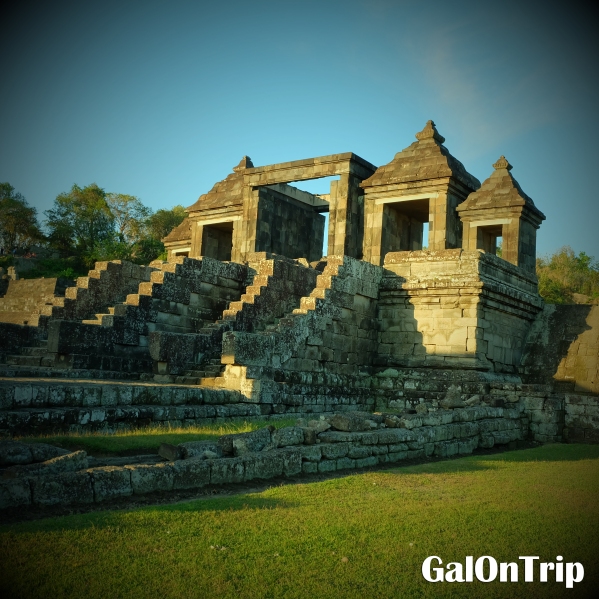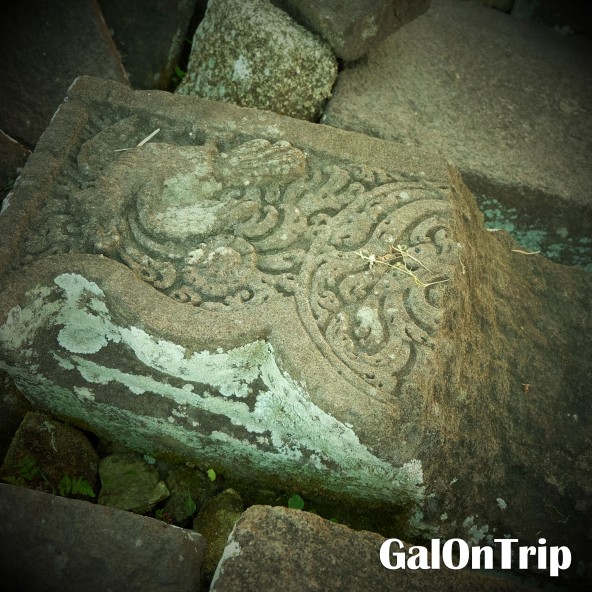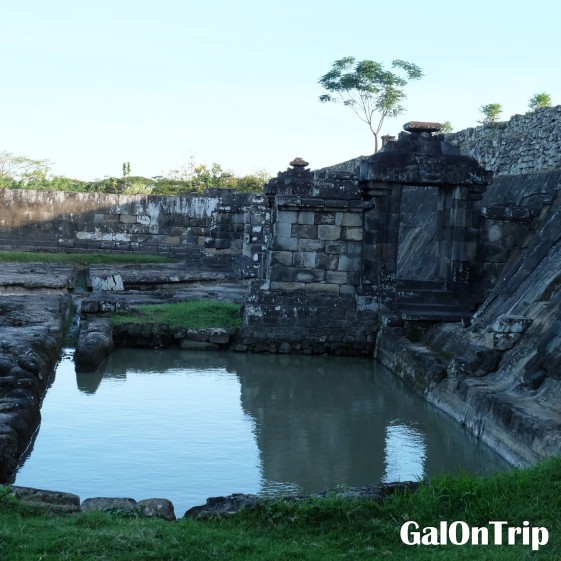Now you can download this article through the following link: https://www.gpsmycity.com/gps-tour-guides/kyoto-1958.html
THE HISTORY OF KIYOMIZU-DERA TEMPLE
Kiyomizu-dera Temple is a Buddhist temple dedicated to Kannon, the Buddhist God of Mercy, situated in the mid-slope of Mt. Otawa in east Kyoto, on the site where Otawa Waterfall produces pure and clean water ceaselessly everyday. It has been listed on UNESCO World Heritage Sites since 1994.
The foundation of Kiyomizu-dera Temple began in 778 when monk Enchin discovered Otowa Waterfall after he had a vision of meeting an old man in white who asked him to find pure water. Near the waterfall, he met Gyoei-koji, the priest who was the incarnation of Kannon. He gave monk Enchin the sacred tree and asked him to carve the thousand-armed Kannon to guard Kannon’s sacred place.
In 780, a warrior named Sakanoue-no-Tamuramaro came to Mt. Otowa to hunt deer. Nonetheless, monk Enchin forbid him to take lives in a sacred land of Kannon and taught about Kannon’s virtuous deeds instead. Deeply moved by his teachings, Sakanoue-no-Tamuramaro built a temple called Kiyomizu, literally means pure water, to worship Kannon.
In the beginning, the temple adopted Hosso sect doctrine until 1965 when it formed its own Kita Hosso sect, a reformed Buddhism with more contribution to the society, founded by Onishi Ryokei Wajo.
Repeatedly burned over the centuries, the buildings you see today at the temple complex were mostly built in 1633.
WHAT TO EXPECT AT THE MAIN TEMPLE

The day after my dining experience in Gion, I continued exploring Kyoto by visiting one of the most-visited temples Kyoto, Kiyomizu-dera Temple. From Kyoto Station, I took bus no. 110 (other options are no. 86, 100, 106, 206, depending on which one comes first) going directly to the temple.
Getting off the bus, it was not directly visible right before my eyes. But I believe I was on the right track after seeing bunch of other visitors going to the same direction, Chawan Zaka or Teapot Lane as part of Higashiyama District, the slope surrounded by souvenir, pottery shops, and kimono rental center. I tried not to get easily distracted by those charming shops since it would take approximately 45 minutes to reach the main temple. Not to mention that I had other destinations to catch in the city apart from Kiyomizu-dera.
The red gate or pagoda, was the first sign that you are already at the temple complex. It was also the starting point where the crowds from various nationalities started to gather for selfie, wefie, or just to save some energy before climbing up more stairs to the famous wooden stage at the main temple.

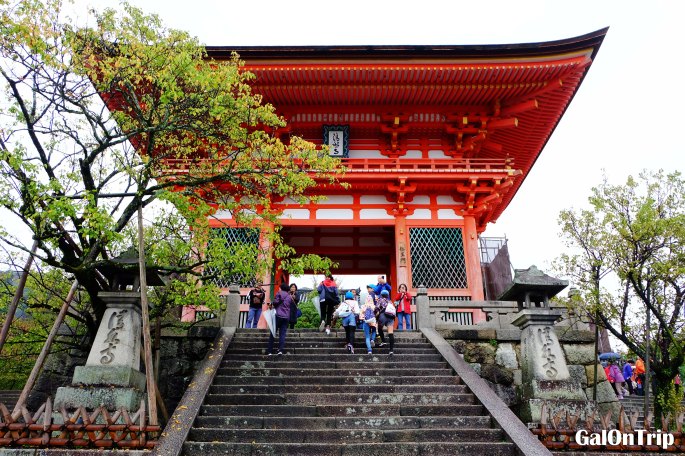
Probably, the only “weakness” (if you wanna call it that way) of a popular destination is the inevitable crowds everywhere you go, no matter whether it’s high or low season. I came in low season and the crowds were still like crazy.

Moreover, it was on the same day as a study tour from some local schools. Despite the crowds, I got neither emotional nor impatient while queuing up. Especially, Japanese people are usually very discipline and cutting each other’s line didn’t happen at all.


Although Kiyomizu-dera is a Buddhist temple, the influence of Shinto remains, distinguishing Buddhism in Japan from that in other countries. For instance, the attributes of Omairi (the ritual of entering Shinto shrine) are available outside the main temple, such as communal basin for temizu (self-cleansing ritual by washing mouth and hands with a wooden scoop) and the prayer to kami (gods) by dropping a coin as an offering, pulling the rope to ring a bell and clapping hands twice.

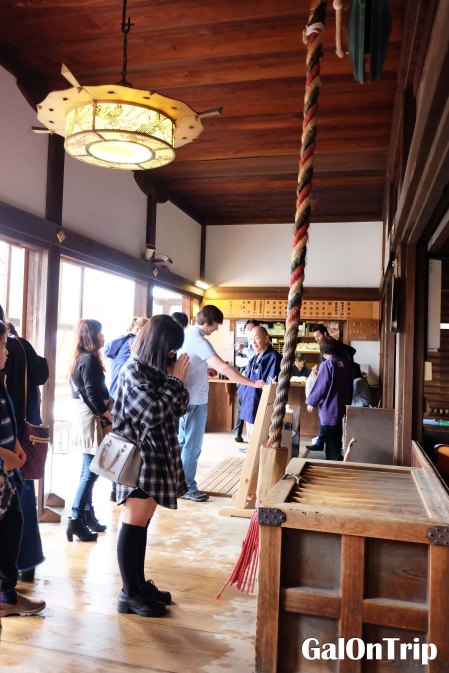
The ultimate destination of visiting Kiyomizu-dera Temple is the most photographed object of the temple, the wooden stage of the main temple that was built without nails. The thousand armed Kannon statue, the main object of worship carved by the monk Enchin, is kept there. Again, be prepared for the crowds!

I was a bit disappointed when I saw the roof of the main stage covered in black cloth for renovation. The bad news is that it stays that way from February 2017 until March 2020. The good news is that thanks to the renovation, the next generation will be able to witness the well-maintained invaluable cultural property in the long run.

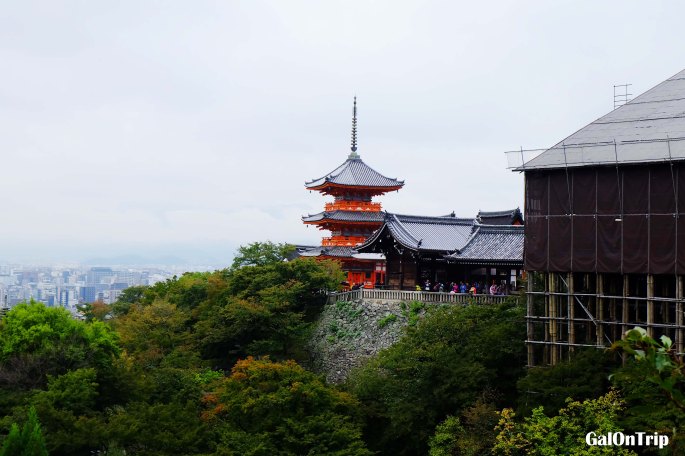
Fortunately, the roof renovation didn’t disturb its function as an observation deck, where I could see Otowa Waterfall and its surroundings from above.

Stretching over 130,000 square meter, Kiyomizu-dera Temple complex also houses Buddhist buildings and other important cultural properties. Among others Okunoin Hall and halls dedicated to Shaka Buddha and Amida Buddha.

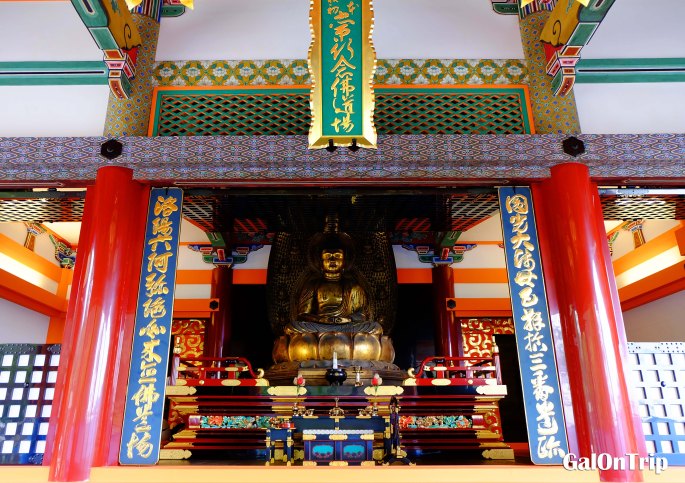
OTHER ATTRACTIONS AT THE TEMPLE COMPLEX
- OTOWA WATERFALL

Since Otowa Waterfall’s discovery by Monk Enchin in 778 and how it became an inspiration of the temple name “Kiyomizu-dera”, meaning pure water, the fame of the waterfall continues until these days. The waterfall consists of 3 separate streams, where each of them is believed to bring success, longevity and love. The sacred water is drinkable, but you only can pick 1 stream, since drinking from all of them defines greed. I didn’t have much patience to line up, though, but I believe it should be fun to “catch” the water using the glass attached with a long pole.
- JISHU SHRINE
The main temple itself is already a magnificent place to visit. Nonetheless, of all the attractions at Kiyomozi-dera Temple complex, Jishu Shrine is definitely my favourite. Rebuilt in 1633 by Iemitsu Tokugawa, Jishu Shrine is a shrine dedicated to the deity of love and matchmaking situated behind the main temple.
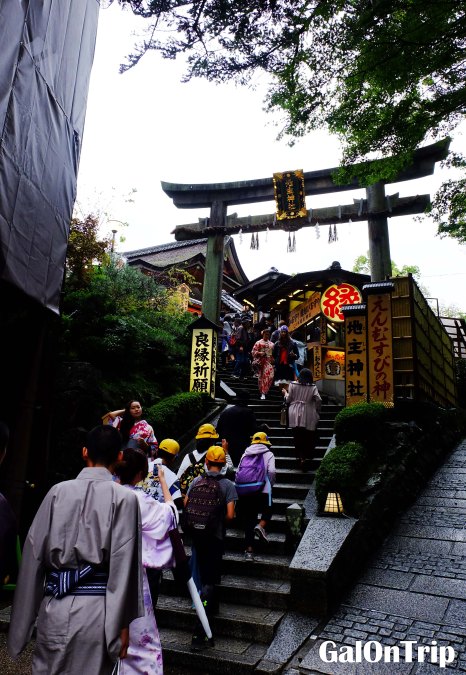
The main God is Okuninushi no-Mikoto, assisted by his messenger, the rabbit whom he once helped when his skin was being peeled off. The three generations of Okuninushi no-Mikoto family are enshrined here, that includes his parents and grandparents.

The main hall of the shrine is one of the prettiest I’ve ever seen because of the multiple colourful small shrines inside the complex. People come to the shrine to pray for finding a true love, long-lasting marriage, getting pregnant easily and save delivery. No wonder why most visitors I saw were young females, some young couples and a very few elderly people.
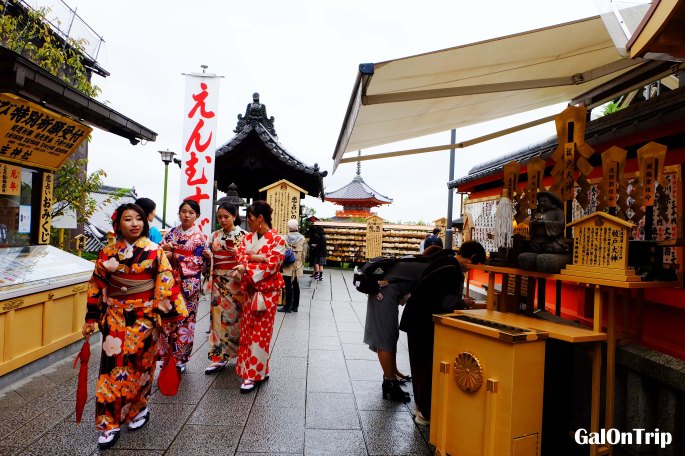
Love stones or Koiuranai no Ishi become the object that draws attention when you enter the shrine because it is believed that if you can walk from one stone to the other one with eyes closed without bumping into someone else means you’ll find a true love. If you need assistance along the way, it means that you need somebody else’s help to find the love of your life.
I spotted a local schoolgirl walking blindfolded with both hands raising to the front, starting from one love stone to the other one about 10 meters ahead. Her schoolmates cheered her while giving some directions to guide her to the right track. I don’t know how long she could reach the other side, but overall it was fun to see people having fun, or truly believe, with the philosophy behind the challenge.

At Jishu Shrine, there are several ways to say your prayer and wishes. Trust me, doing some of them (if not all) could be a lot of fun whether you’re a believer or not.
You can write your prayer, wishes and gratitude on an ema votive tablet, obtainable at the souvenir shop, and hang it on the designated “tree”. The price starts from ¥300 to ¥800 depending on the design. For those who have a talent in drawing and calligraphy, it’s time to shine. You can express your creativity whatever you like on the table. Isn’t it cool?
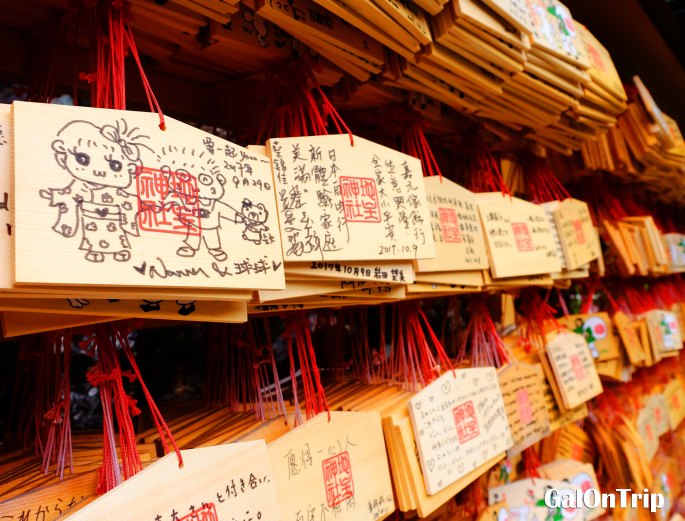
Another way to make a wish is to play Omikuji, a fortune telling game. Shake the provided box while making a wish until the stick comes out, defining a drawer number you need to open. Inside the drawer, there’s a piece of paper telling about your future. If says good things, keep the paper. Otherwise, you can fold and hang it on the “hanger” close to the drawer.


Also, there’s a spot where you can write all the troubles and problems in your life on a piece of paper available inside the box. After that, put it in the wooden bucket filled with water to wash away all your troubles. I wish life could be that simple and easy!



It is believed that patting Nade-Daikoku-San (Daikoku to be patted), a bronze statue of a man carrying a Santa Claus lookalike sack, can make any kind of wishes and prayers come true.

- HIGASHIYAMA DISTRICT
After leaving Kiyomizu-dera complex, make sure you spend more time in Higashiyama District, a long street sloping down to the main street where public buses stop, as there are many tempting stores selling souvenirs, artisan jewelry designs, pottery, sweets (from ice cream to mochi), pickles and restaurants.

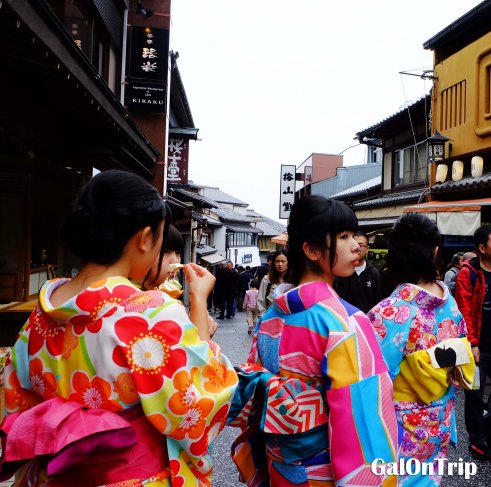
If you don’t like crowds that much, sorry to say that it’s always very very crowded, even in low season. But still, I suggest you to explore this area slowly.
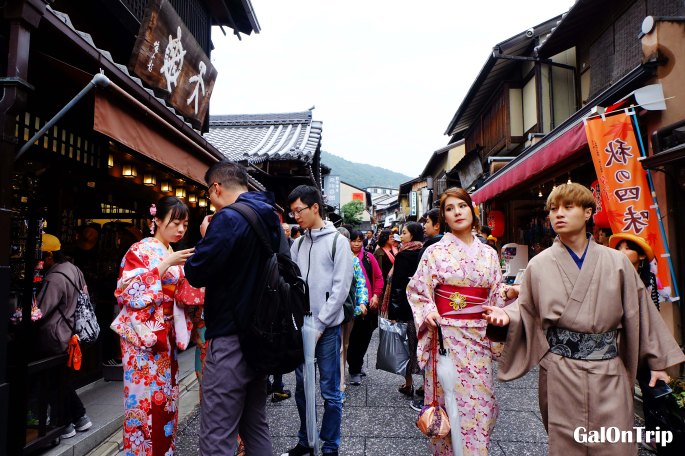


I was so happy that I finally found my favourite snack at Yatsu Hashi Chou. The choux tasted like nowhere else in the world, with lightly-tasted cinnamon bun with green tea filling. Suppose you wonder how green tea and cinnamon can match perfectly, don’t think too much. For the price of ¥400, it was worth it.
And don’t forget to try the bottled green tea as well. It is a bit expensive though, ¥400 for 250 ml, compared to those from the vending machine, but the quality of the tea is so much better. There are 2 options, sweetened and unsweetened. I tried the sweetened one, and all I can say is that I’d rather have the unsweetened one, although the sweetened one tasted just fine.
The mural of a beautiful woman in flowers was the farewell sign of my visit to Kiyomizu-dera Temple. There’s nothing more I can say that it’s one of the best attractions I visited in Kyoto, thanks to its variety of interests combining fun and holiness simultaneously.
I was happy that I decided to revisit Kyoto the year after and finally could make it to Kiyomizu-dera Temple!

Now you can download this article through the following link: https://www.gpsmycity.com/gps-tour-guides/kyoto-1958.html






